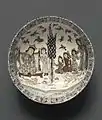
Lustreless bowl Iran-Seljuk period, 13th century.
Seljuk pottery was the pottery of the Seljuk Empire. With the end of the Seljuk Empire in the 14th century, the Ottoman Empire took over some of the traditions of the Seljuks, especially in the early stages of İznik pottery.[1]
Tiles are known from the Seljuk period, which use the minai technique. The technique involved the use of seven colors, with blue, green and turquoise applied on an underglaze and fired. Other colors such as yellow, red, white, black and sometimes gilt were then applied on top of this, and re-fired at a lower temperature.[1]
 Lustreless ewer, Iran, Seljuk period, 12th century.
Lustreless ewer, Iran, Seljuk period, 12th century. Glazed Anatolian Seljuk tile, Konya, 2nd half of 12th century.
Glazed Anatolian Seljuk tile, Konya, 2nd half of 12th century. Bowl with an Enthronement Scene. Seljuk, c.12th century Brooklyn Museum
Bowl with an Enthronement Scene. Seljuk, c.12th century Brooklyn Museum.jpg.webp) Bowl with an Enthronement Scene, c.13th century Brooklyn Museum
Bowl with an Enthronement Scene, c.13th century Brooklyn Museum
See also
References
- 1 2 Istanbul Archaeology Museums permanent exhibit
This article is issued from Wikipedia. The text is licensed under Creative Commons - Attribution - Sharealike. Additional terms may apply for the media files.